bulletin | cover story
DEFORM TO PERFORM:
Dislocation-tuned properties of ceramics
Engineering dislocations into ceramics paves the road to harness versatile, unexpected functional and mechanical properties, which may open a new era for dislocation-based ceramic technologies.
By Xufei Fang, Atsutomo Nakamura, and Jürgen Rödel
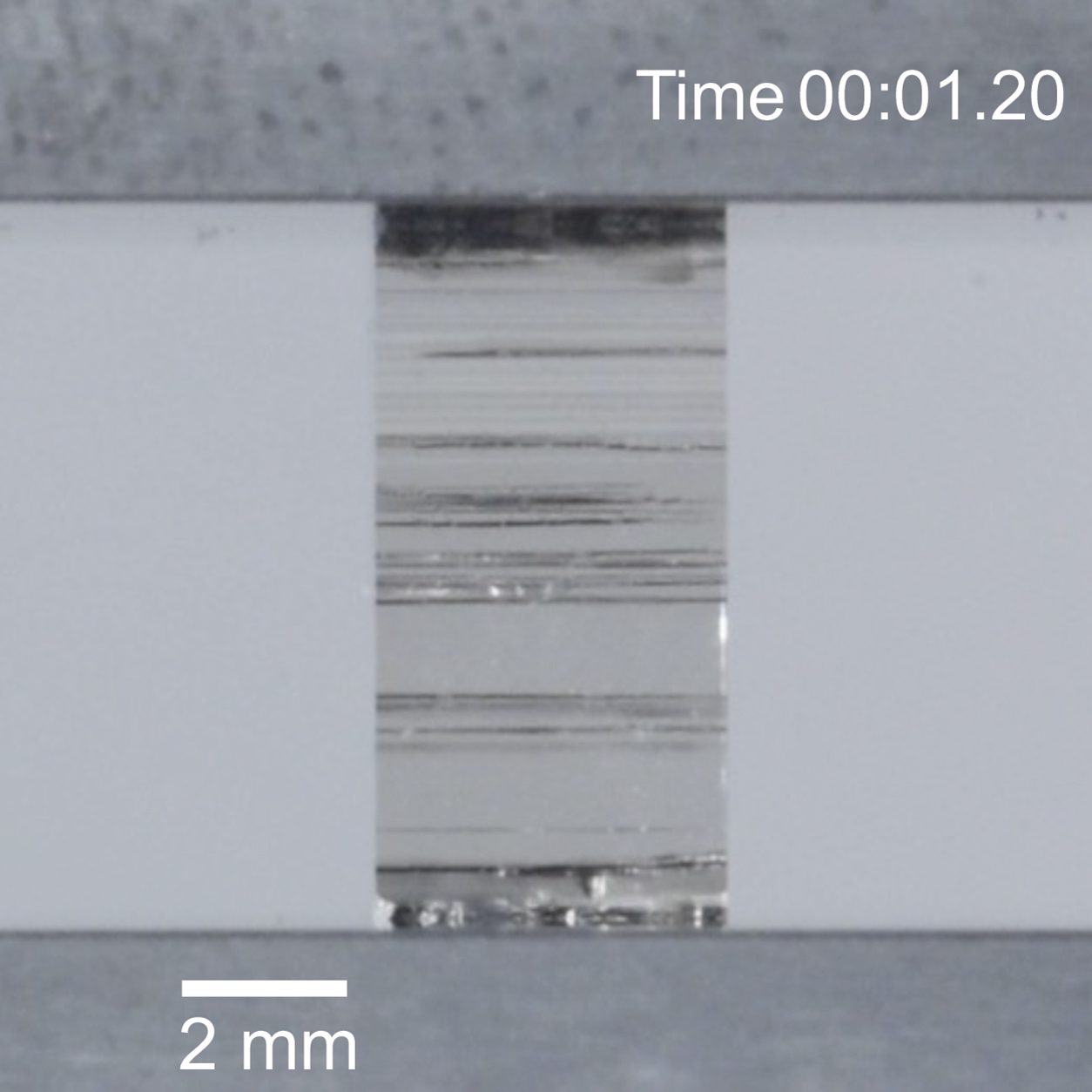

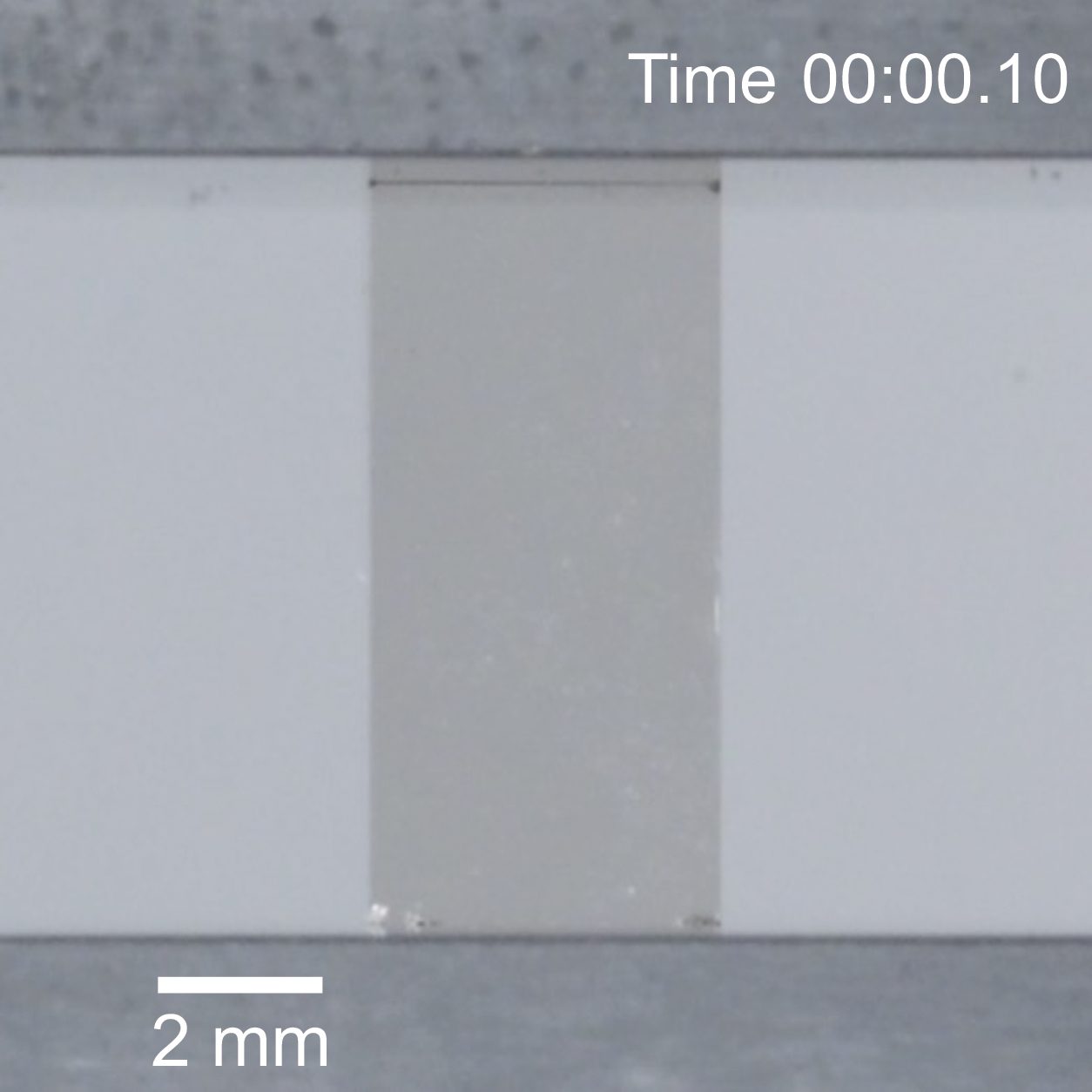
Single-crystal strontium titanate deformed at room temperature during bulk compression.
Credit: Fang, Nakamura, and Rödel
Most materials science textbooks teach us that ceramics are infamously brittle due to the strong ionic and/or covalent bonding, and thus display little or almost no plasticity, particularly at room temperature.
Yet there are growing reports of ceramic materials (predominantly in single-crystal form) that can plastically deform at room temperature, with some of these discoveries tagged as “surprising” (for strontium titanate)1 or “extraordinary” (for zinc sulfide).2
How are researchers achieving such counter-intuitive results? While several techniques have brought limited success (described in the next section), methods for engineering dislocations into ceramics have led to the most significant developments. This article will summarize these developments and consider what is next for the field of dislocations in ceramics.
From improved fracture toughness to ductile ceramics
Ceramics have much lower fracture toughness (about several MPa·m1/2) compared to metals (normally tens and hundreds of MPa·m1/2). This brittleness significantly limits the technological application of ceramics as structural or load-bearing materials.
Researchers have explored various ways to improve the fracture toughness of ceramics. The 1975 Nature paper “Ceramic steel?” successfully ignited (phase) transformation toughening of ceramics.3 However, to date, this mechanism works mainly for zirconia-based ceramics. To toughen other types of ceramics, researchers have concentrated efforts on the bridging mechanisms and process-zone toughening, in addition to crack deflection.4
Rather than simply toughening ceramics, overcoming the inherent brittleness of ceramics so that they can plastically deform is an enduring pursuit that traditionally has met with limited success. One recent novel approach, namely “bond switching” for a dual-phase structure with coherent interface design, achieved room-temperature plastic deformation in silicon nitride with covalent bonding up to a total engineering strain of about 32%.5 But this approach—which seems to have met the requirement of “changing the bond strength,”6 which is a prerequisite for dislocation motion in metals5—is limited to the submicrometer range, and the general applicability in bulk samples remains elusive.
Dislocations are one-dimensional line defects that are the main carriers of plastic deformation in crystalline solids. Nowadays, dislocation-mediated plastic deformation is best known in metallic materials.
Dislocation research in ceramics
Apart from the above endeavors, since the late 1950s, a rather continuous line of research on ductile ceramics has focused on dislocations.
Dislocations are one-dimensional line defects that are the main carriers of plastic deformation in crystalline solids. Nowadays, dislocation-mediated plastic deformation is best known in metallic materials. It is, however, worth mentioning that the very first systematic studies on dislocation multiplication and motion were conducted on nonmetallic lithium fluoride by Gilman and Johnston using the chemical etching method,7,8 which coincides with the rising prominence of transmission electron microscopy in the mid-1950s.
With the difficulty of inducing plasticity in most ceramics at room temperature, investigations of dislocations in ceramics initially focused on alkali halides and magnesium oxide. The development of high-temperature mechanical testing techniques in the 1950s gradually opened the window for probing dislocations in more ceramics, with many more studies in this field taking place in the 1970s–1980s.9
Since about 2003, various promising proofs-of-concept for a wide range of functional properties tuned by dislocations in ceramics were identified and investigated,10 revealing a new research wave that likely will open a new chapter for dislocation engineering in ceramics.
New perspective for dislocations in ceramics
Charged feature of dislocation cores in ceramics
Unlike metals, dislocations in ceramics with ionic and/or covalent bonding may carry charges at their cores,12,13 with a surrounding space charge layer for charge compensation (Figure 1a). For instance, the bright-field scanning transmission electron microscopy image in Figure 1b demonstrates a nonstoichiometric dislocation core in aluminum oxide (α-Al2O3). The lateral charge extension can be described by the Debye-Hückel radius (Figure 1a). Its value is prone to change if the charge of the core can be altered. For instance, reducing oxide samples with dislocations at high temperatures has been found to change the charge carrier concentrations around dislocations.14
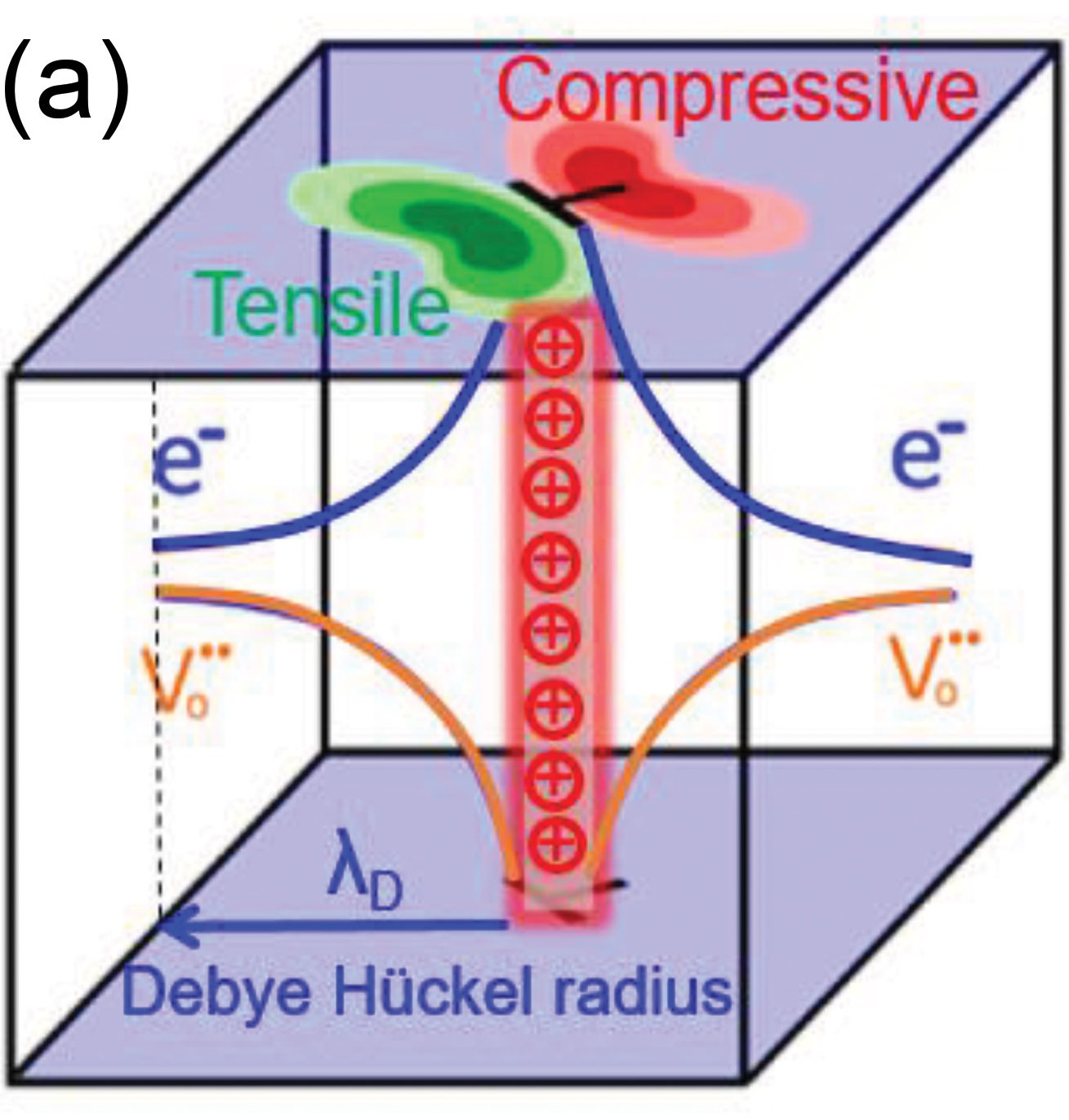
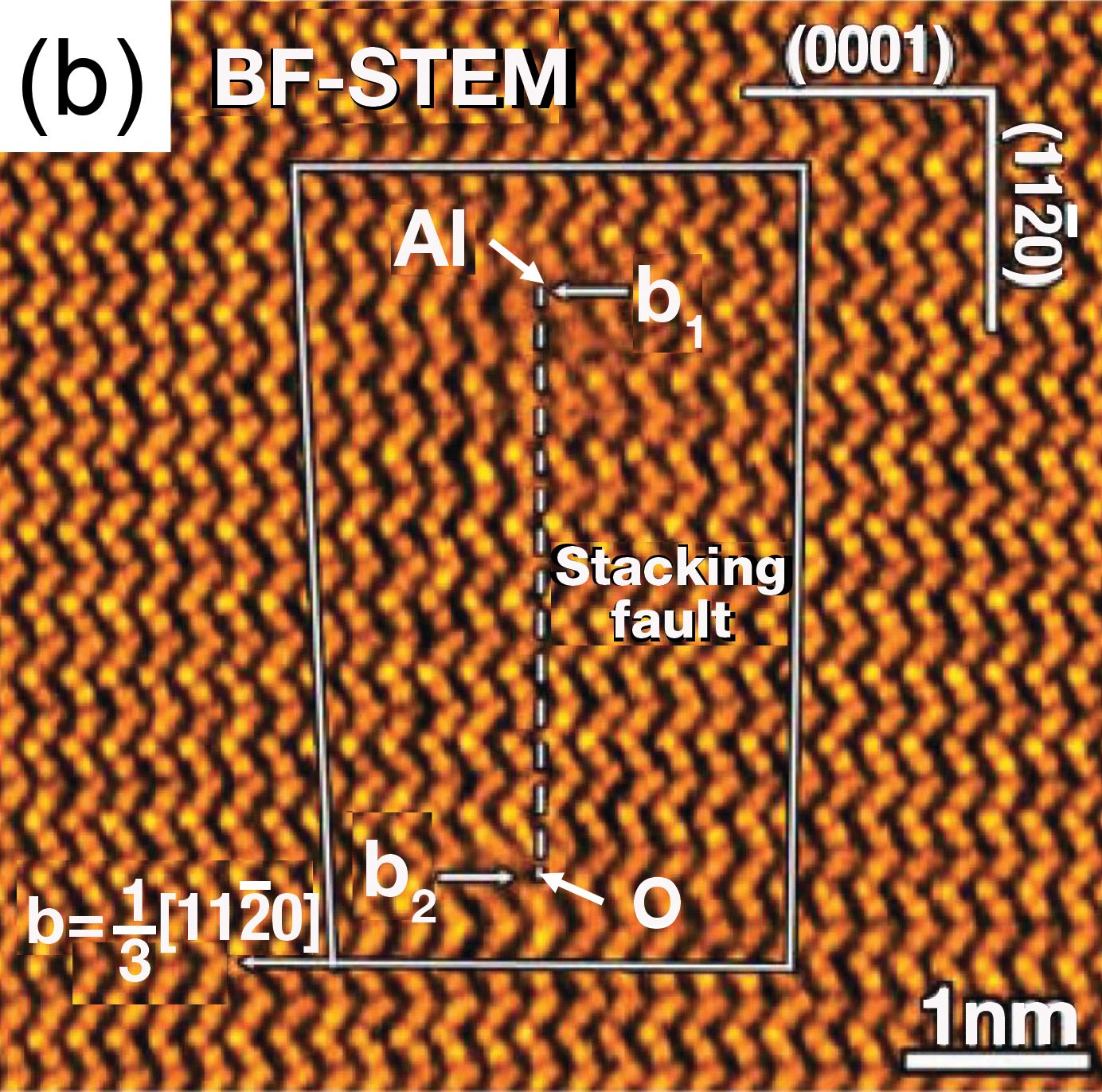
Figure 1. (a) Schematic of a positively charged edge dislocation core with a compensating space charge surrounding it. The Debye-Hückel radius of the space charge is indicated by λD. The elastic stress fields are indicated on top of the sketch. Credit: Fang, Nakamura, and Rödel
Figure 1. (b) Atomic-resolution bright-field scanning transmission electron microscopy (BF-STEM) image of a basal edge dislocation core in aluminum oxide (α-Al2O3), illustrating a typical core structure of a basal dislocation observed from the ⟨1-100⟩ direction. The dislocation core is dissociated into two partials (⅓ ⟨10-10⟩ and ⅓ ⟨01-10⟩) connected by a {11-20} stacking fault, with the upper partial core terminated by an aluminum column, whereas the lower partial core is terminated by an oxygen column. Both core terminations lie in between the aluminum and oxygen atomic planes. Each partial core is nonstoichiometric due to the excess of aluminum or oxygen, suggesting possible charged cores. Figure (b) reprinted/adapted with permission from Ref. 11. Copyright 2007, American Association for the Advancement of Science. Credit: Shibata et al., Science
Dislocation-tuned functional properties
The charges of the dislocation core, together with the high local strain field surrounding dislocations, bring vast opportunities to tune the mechanical and physical properties in ceramics. For instance, dislocations in ceramics can: 1) tune the potential barrier for thermal or electrical scattering; 2) act as pinning centers for domain walls in ferroelectrics; 3) provide sites for enhanced transport and reaction rate owing to the local atomic distortion; and 4) serve as self-doping elements to local charge states and local bandgaps of the material.
Moreover, in contrast to point defects that suffer from a drastic decrease in stability due to thermal activation at elevated temperatures, dislocations provide much better structural stability at high temperatures. For instance, high-temperature stability was reported up to 1,200°C in polycrystalline strontium titanate.15 This thermal stability enables potential new applications by shifting the boundary for current applications to much higher temperatures. The impact of employing dislocation networks to tailor functional oxides is promising, such as “hard” piezoelectrics for electronic applications, electronic or ionic conductors, thermoelectrics, and photoconductivity (Figure 2).
Most recently, Höfling et al. mechanically imprinted dislocation networks into bulk single-crystal barium titanate by uniaxial creep experiments at 1,150°C, which led to a 19-fold increase in the large-signal piezoelectric coefficient (d33*).16 Such a giant increase is attributed to the ferroelectric domain structures being skewed by dislocations, which strongly modify the electromechanical forces for dislocation-domain interaction.
As for room-temperature deformation, Hameed et al. reported dislocation-tuned superconductivity well above the superconducting transition temperature in single-crystal strontium titanate that was plastically deformed at room temperature.17 The superconducting transition temperature increases as high as 30–50°C in the deformed sample, which is suggested to be influenced by the local strain surrounding the dislocations.
Further explorations of dislocation-based electrical properties in strontium titanate as well as titanium dioxide have been reviewed by Szot et al.18
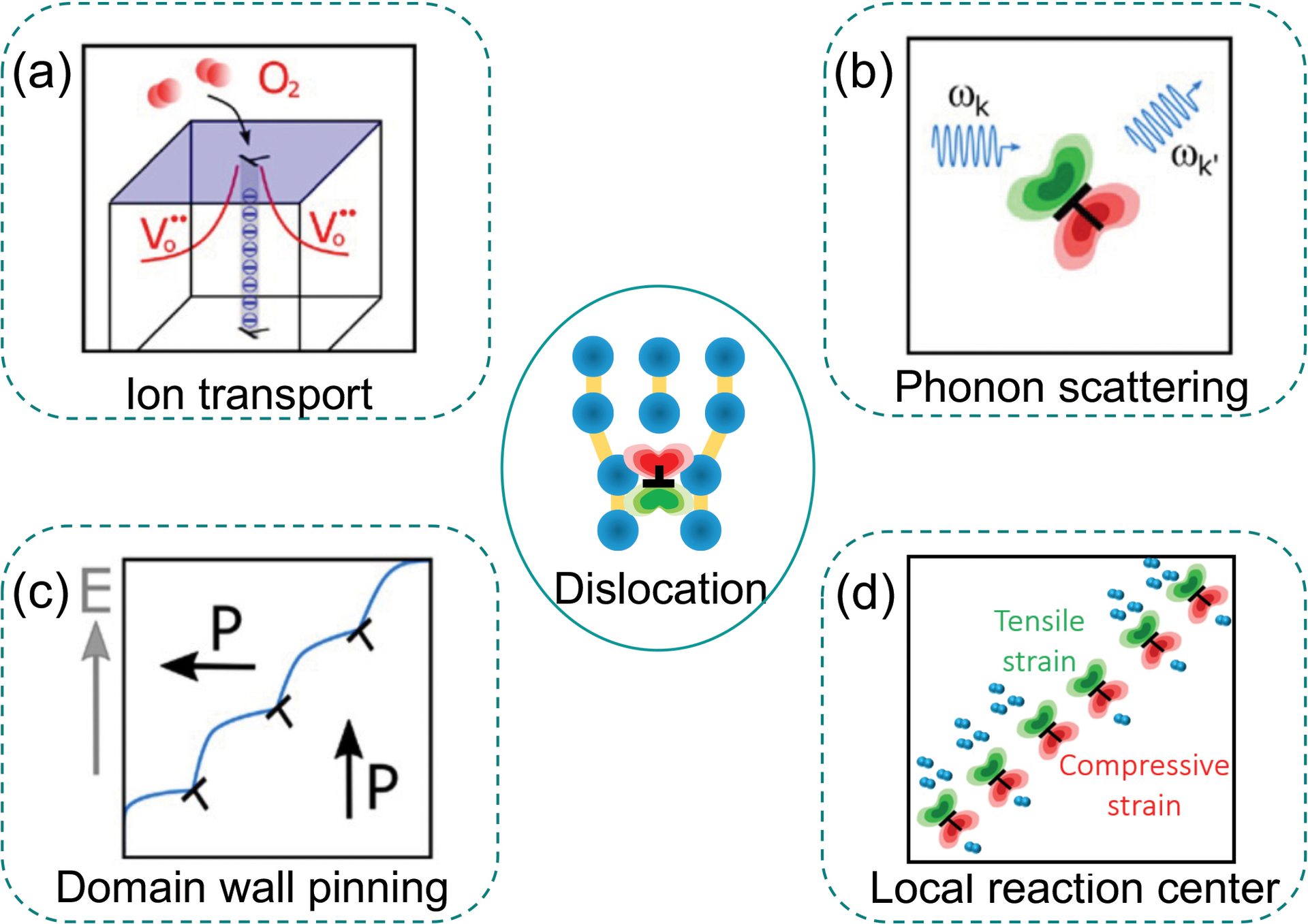
Figure 2. Perspectives for versatile functional applications: (a) dislocations act as a fast diffusion path for oxygen, holding potential for solid oxide fuel cells; (b) dislocations scatter phonons to reduce thermal conductivity, benefiting the thermoelectric figure of merit; (c) dislocations act as pinning centers for domain walls, leading to enhanced electromechanical properties in ferroelectrics; and (d) dislocations act as local active centers, boosting reaction rates.
Credit: Fang, Nakamura, and Rödel
Dislocation-tuned mechanical properties
As dislocations are one of the main carriers for plastic deformation, it is expected that engineering dislocations into ceramics can significantly impact the mechanical properties, such as yield strength, hardness, and creep. Most significantly, dislocations can improve fracture toughness and damage tolerance to combat the brittleness of ceramics.
For instance, Li et al. reported about 12% plastic strain at room temperature with micropillar compression of flash-sintered titanium dioxide.19 The large plasticity (six times higher than conventionally sintered titanium dioxide) is proposed to be caused by the enrichment of preexisting dislocations and stacking faults generated during the highly nonequilibrium sintering process. Besides tailoring plasticity, Porz et al. demonstrated a two-fold increase of the crack-tip toughness by engineering surface dislocations into single-crystal strontium titanate.20
Dislocations with charged cores exhibit both elastic and electrostatic characteristics, which are subject to modifications in physical fields (e.g., light irradiation, electric field). This charged feature marks another fundamental difference between dislocations in ceramics and metals (which only have elastic characteristics), offering new opportunities to tune the dislocation-mediated plastic deformation and fracture toughness.
Recently, Oshima et al. provided a striking example of photoplasticity in bulk single-crystal zinc sulfide: An ultimate plastic strain of about 45% was observed in complete darkness, contrasting the almost immediate fracture (~2% strain) under ultraviolet light (365 nm).2 Such an effect was coined as photoplasticity, with the impact of light most significant near the absorption edge of the bandgap. The decreased plasticity of zinc sulfide in ultraviolet light was attributed to the suppressed dislocation mobility caused by the reconstruction of charged dislocation cores due to electron–hole pairs excited by light.
Besides light illumination, electric field and electron beam injection can also significantly impact the plastic behavior of ceramics (even at room temperature), possibly by altering the local electronic state of dislocations. A combination of these external fields with mechanical loading may hold a key to unlocking room-temperature plasticity in many more ceramic materials.
As dislocations are one of the main carriers for plastic deformation, it is expected that engineering dislocations into ceramics can significantly impact the mechanical properties, such as yield strength, hardness, and creep. Most significantly, dislocations can improve fracture toughness and damage tolerance to combat the brittleness of ceramics.
Ceramic dislocation toolboxes
Toolbox: Engineering dislocations into ceramics
To tune the functional and mechanical properties of ceramics, the prerequisite is to engineer dislocations with controllable densities and a scalable plastic zone size. Ideally, the spatial arrangement of dislocations and their mesostructure would be controllable as well.
Due to the brittleness of most ceramics, engineering dislocations into ceramics without crack formation remains one of the most pressing bottlenecks.
In brief, dislocation engineering in ceramics can be achieved mainly by a) interface design; b) processing; and c) mechanical deformation.
a) Interface design. Well-aligned dislocations can be produced by bicrystal interface bonding,21 while the interface lattice mismatch may produce high-density threading dislocations during thin film growth. Both methods require strict fabrication parameters (e.g., temperature, pressure, impurity of the crystals) to achieve samples of high quality, and they are not suitable for mass production. Moreover, this method currently provides only a well-structured interface and not a bulk material.
b) Processing. High densities of dislocations up to about 1014/m2 were reported using new sintering techniques (e.g., flash sintering of titanium dioxide).19 These processing techniques yield polycrystalline samples that are very often rich in pores and microcracks, and grain boundaries also add to the structural complexity.
c) Mechanical deformation. Dislocations can be induced by bulk compression at both room temperature and high temperature,1 or via micromechanical testing, such as nanoindentation.22 Additionally, simple surface grinding was found to achieve an extremely high dislocation density (up to ~1015/m2) in strontium titanate,23 although it is limited only to the near-surface region (~2 μm in depth, Figure 3).

Figure 3. Overview of mechanical engineering approaches to tune dislocation density and plastic zone size in single-crystal strontium titanate at room temperature. The dislocations are visualized either directly by transmission electron microscopy and chemical etching, or indirectly by slip traces after plastic deformation. Note that the dislocation density in undeformed reference samples is about 109/m2.
Credit: Fang, Nakamura, and Rödel
Among these approaches, mechanical deformation offers the opportunity to align dislocations in the sample on their slip planes for functional anisotropy. However, due to the high Peierls stress in most ceramics, plastic deformation in these ceramics strongly relies on thermal activation and dislocation dissociation. Dislocations are thus introduced mainly via high-temperature bulk compression above 1,000°C.
Plastic deformation is featured by discrete surface slip bands after deformation, with dislocation-rich regions extracted for functionality evaluation. In fact, quite a few ceramic materials exhibit large plasticity at temperatures below 800°C, which holds much potential for engineering.
Here, we focus on dislocation engineering via mechanical deformation. To this end, we present a specific example of room-temperature deformation of single-crystal strontium titanate, a prototypical perovskite with cubic structure at room temperature.
In 2001, Brunner et al. found that single-crystal strontium titanate can yield plastic deformation up to about 7% in uniaxial bulk compression even at room temperature.1 The discovery was termed “surprising” in the original publication title. After this work, there were quite a few studies on the plastic deformation of strontium titanate ranging from –196°C (liquid nitrogen) up to about 1,500°C,24 from bulk deformation to nanoscale testing.22 Single-crystal strontium titanate therefore became a model material to study, particularly in regard to room-temperature dislocation plasticity.
Figure 3 summarizes the methods to mechanically engineer dislocations into single-crystal strontium titanate at room temperature (note the uniaxial bulk compression test is not displayed in Figure 3 due to its wide application). Dislocation densities from about 109/m2 (in undeformed reference samples) up to about 1015/m2 were achieved, with a continuous plastic zone size from hundreds of nanometers up to mm- or cm-sized regions without crack formation. The authors of this article achieved these results by addressing the dislocation mechanics in strontium titanate (dislocation nucleation, multiplication, motion, and their competition), which will be discussed in the following section.
Plastic deformation is featured by discrete surface slip bands after deformation, with dislocation-rich regions extracted for functionality evaluation. In fact, quite a few ceramic materials exhibit large plasticity at temperatures below 800°C, which holds much potential for engineering.
Toolbox: Dislocation mechanics in ceramics
In addition to the above experimental toolbox, this section focuses on the overarching engineering principles for dislocations in ceramics from the mechanics perspective.
The primary goal of dislocation engineering in ceramics is to avoid crack formation while promoting dislocation-mediated plastic deformation. Different to most metallic materials, ceramics at room temperature have limited slip systems that can be activated. (In most cases, there are only two independent slip systems, although physically there are six interdependent slip systems that can be activated, e.g., in sodium chloride and strontium titanate). The limited number of slip systems at room temperature does not fulfill the von Mises criterion, which is required for general plastic deformation in polycrystalline materials.
To circumvent this limitation, most studies of plastic deformation in ceramics were limited to single crystals. Focusing on single crystals, we suggest examining the dislocation-based plasticity from the following aspects: dislocation nucleation, dislocation multiplication, dislocation mobility, and the potential competition among these aspects.
Specifically, for room-temperature plastic deformation, one needs to select target materials that display appreciable dislocation mobility, which is the case for most alkali halides, strontium titanate, magnesium oxide, and zinc sulfide in bulk deformation, as mentioned above. It would not be feasible to aim for room-temperature bulk plastic deformation in aluminum oxide, for example, due to the extremely high lattice friction stress (several GPa at room temperature), except for nanoindentation or micro- or nanopillar compression.
Furthermore, it is worth noting that the potential competition among the above three fundamental factors (dislocation nucleation, multiplication, and mobility) can lead to interaction and reaction of dislocations, which may result in crack initiation. On the other hand, by applying external physical stimuli (e.g., electric field, light illumination, and magnetic field), the dislocation mechanics can be altered to significantly enhance or suppress the plastic deformation, as coined by electroplasticity, photoplasticity, and magnetoplasticity. The impact of external fields on dislocation mechanics, particularly how the fields are interacting with the (charged) dislocation cores, requires more extensive studies.
Because most ceramics have low fracture toughness (resistance to crack propagation), once cracks are nucleated or present, it becomes challenging to keep the cracks from propagating under external loading. Hence, we would like to point out that, in addition to the ongoing endeavors of using dislocations to increase the fracture toughness of ceramics,20 a more appealing path is to focus on increasing the threshold for crack initiation based on dislocations, namely, improving the damage tolerance. If the crack initiation can be effectively suppressed (most relevant for single crystals or highly dense polycrystalline samples), the threshold for the onset of material failure would be correspondingly improved.
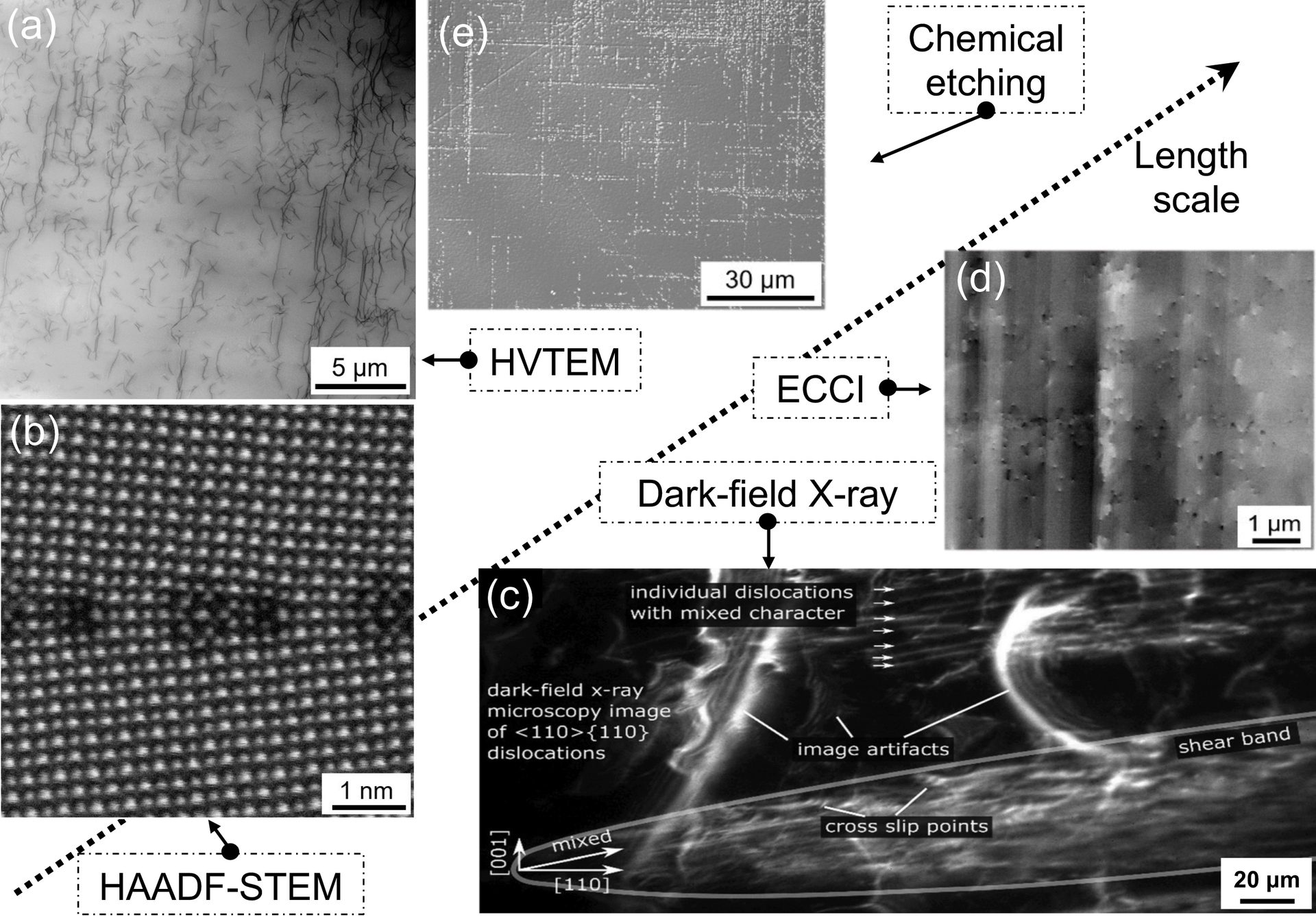
Figure 4. Representative characterization methods for dislocations in ceramics based on strontium titanate: (a) High-voltage transmission electron microscopy (HVTEM) featuring dislocations (dark lines) over a large view; (b) Dislocations at a low angle grain boundary imaged by scanning transmission electron microscopy (STEM) with a Cs-corrector for atomic resolution); (c) Dark-field X-ray microscopy features the dislocations (white contrast) in the shear bands; (d) Electron channeling contrast imaging (ECCI) image revealing the dislocations as bright spots in the near surface area; and (e) Dislocation etch pits (white spots) after chemical etching. Figure (c) reprinted/adapted with permission from Ref. 20. Copyright 2021, American Chemical Society.
Credit: a,b,d,e) Fang, Nakamura, and Rödel; c) Porz et al., Materials Horizons
Toolbox: Characterization of dislocations
A comprehensive understanding of dislocation mechanics for better control of dislocation engineering, as well as for better design of dislocation-tuned functional and mechanical properties, depends closely on the characterization of dislocations (sub)structure and their spatial arrangement. Thanks to the development of various techniques for revealing and imaging dislocations, a rich variety of tools is available.
As depicted in Figure 4, various techniques are available to probe dislocations at different length scales, with a focus on different structural characterizations spanning from atomic scale up to macroscale.
For instance, the scanning transmission electron microscopy method with a Cs-corrector is recognized as the best method for observing the atomic arrangement with atomic resolution. Thus, it has been an indispensable tool to probe the dislocation core, which is believed to hold the key to opening the design of next-generation functional materials using dislocations.
Chemical etching, the most classical approach, has been employed since the 1950s. This method allows for the study of the dislocation surface distribution in areas ranging from microscale (micrometer) up to macroscale (millimeter). The elegant works by Gilman and Johnston on lithium fluoride were briefly mentioned before.7,8
In addition to these techniques, it is worth mentioning that high-voltage transmission electron microscopy (HVTEM, with an acceleration voltage up to 1 MV, which became commercially available at the end of the 1960s, first in Japan) has been historically employed to study dislocation mechanics, allowing a much larger view of sample size (up to tens of micrometers) with higher sample thickness. For instance, Messerschmidt et al. systematically investigated the dislocation behavior in single-crystal magnesium oxide back in the 1970s and 1980s.25 Their results brought abundant insights into dislocation motion and dislocation-crack tip interactions, yet the value of such work was underrated due to historical reasons, probably also because of the limited material system being investigated (magnesium oxide).
For other techniques such as electron channeling contrast imaging, dark-field X-ray microscopy, and dislocation decoration, readers are referred to the literature for more details.
A comprehensive understanding of dislocation mechanics for better control of dislocation engineering, as well as for better design of dislocation-tuned functional and mechanical properties, depends closely on the characterization of dislocations (sub)structure and their spatial arrangement. Thanks to the development of various techniques for revealing and imaging dislocations, a rich variety of tools is available.
Some open questions
Exciting and promising progress has been made in the past few years, extending the boundary of our understanding of dislocations in ceramics. Nevertheless, quite a few open questions remain to be answered. For instance,
- What are the fundamental mechanisms for controlling dislocation plasticity in ceramics? Why are some ceramics (e.g., single-crystal strontium titanate, potassium niobate, magnesium oxide, zinc sulfide, calcium fluoride) plastically deformable at room temperature while most others (even with the same crystal structure, e.g., barium titanate) are not? How can we identify or predict more room-temperature deformable ceramics?
- External stimuli, such as light irradiation, electric field, and magnetic field, may dramatically affect the plasticity of some ceramics, even at room temperature, by changing the dislocation multiplication and mobility. How can we use such physical fields to efficiently and effectively assist the plastic deformation of ceramics?
- Point defects, such as oxygen vacancies, in ceramic oxides can carry charges. How would the charged point defects interact with the charged dislocation cores, and thus potentially impact the mechanical and functional stability over a long-time span? In particular, how would the external stimuli affect such interactions?
Concluding remarks
As the numerous studies referenced throughout this paper show, the conventional belief that “ceramics are brittle” can be misleading and should be addressed more carefully, for example, by specifying the temperature and scale at which fracture occurs.
For an advanced understanding of dislocation-mediated plastic deformation of ceramic materials, it is necessary to clarify the boundary conditions for mechanical deformation. For example, having or not having preexisting dislocations in the volume can make a significant difference on the plastic deformation of ceramics, as in the case of dislocation-rich, flash-sintered titanium dioxide samples that display appreciable plastic strain.
The same holds true for the deformation volume containing preexisting cracks or not. Regarding boundary conditions, the loading scenario (bulk compression or micro- or nanopillar compression), the temperature (high temperature or room temperature), the texture (single, bi- or polycrystalline), and even the strain rate during deformation can be detrimental for the outcome of plasticity or cracking.
Further progress will hinge on an extension of the deformation toolboxes based on, for example, prototypical strontium titanate toward other functional ceramics. An ultimate question most relevant for engineering application is, how far is it still to really achieve the “dislocation technology”10 in functional ceramics? This achievement not only requires expertise and knowledge of mechanics, but it also requires in-depth characterization and understanding of the electronic structure induced by dislocations, which is closely related to the electrical conductivity, superconductivity, photoconductivity, and thermal conductivity, to name a few.
Overall, we expect to see a rise of dislocation studies in ceramics in the coming years, and a joint effort will undoubtedly be beneficial for advancing this exciting field.
Acknowledgements
Xufei Fang acknowledges the support of the Athene Young Investigator Program at TU Darmstadt, Germany. Atsutomo Nakamura acknowledges the support by JSPS KAKENHI (grant no. JP19H05786 and JP21H04532). Jürgen Rödel is supported by the Deutsche Forschungsgemeinschaft (DFG) under grant no. 414179371.
About the authors:
Xufei Fang is group leader at TU Darmstadt and Karlsruhe Institute of Technology in Germany, and guest associate professor at Osaka University, Japan. Atsutomo Nakamura is professor at Osaka University. Jürgen Rödel is professor at TU Darmstadt and an ACerS Fellow. Contact Fang at fang@ceramics.tu-darmstadt.de.

